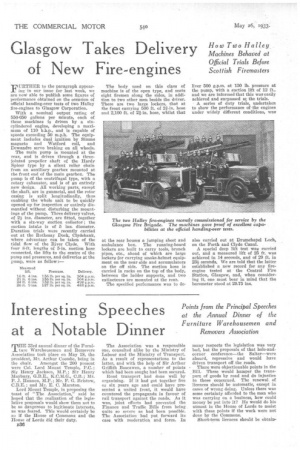Glasgow Takes Delivery of New Fire-engines
Page 50

If you've noticed an error in this article please click here to report it so we can fix it.
How Two Halley Machines Behaved at Official Trials Before Scottish F iremasters
URTHER to the paragraph appear ing in our issue for last week, we are no able to publish some figures of performance obtained on the occasion of official handing-over tests of two Halley fire-engines to Glasgow Corporation.
With a nominal output rating of 550-650 gallons per minute, each of these machines is driven by a sixcylindered engine, developing a maximum of 110 b.h.p., and is capable of speeds exceeding 50 m.p.h. The equipment includes dual ignition by Simms magneto and Watford coil, and Dewandre servo braking on all wheels.
The main pump is mounted at the rear, and is driven through a threejointed propeller shaft of the Hardy Spicer type by a silent roller chain from an auxiliary gearbox mounted at the front end of the main gearbox. The pump is of the centrifugal type, with a rotary exhauster, and is of an entirely new design. All working parts, except the shaft, are in gunmetal, and the rotor casing is split longitudinally, thus enabling the whole unit to be quickly opened up for inspection or entirely dismantled without disturbing the mountings of the pump. Three delivery valves, of 2 ins, diameter, are fitted, together with a six-way FUCtion. collector ; the suction intake is of 5 ins. diameter. Duration trials were recently carried out at the Rothesay Dock, Clydebank, where advantage can be taken of the tidal flow of the River Clyde. With four 84t. lengths of 5-in. suction hose connected, the lifts to the centre of the pump and pressures, and deliveries at the pump, were as follow:—
The body used on this class of machine is of the open type, and seats eight firemen along the sides, in addition to two other men beside the driver. There are two large lockers, that at the front carrying 500 ft. of 2i-in. hose and 2,100 ft. of 2i-in. hose, whilst that at the rear houses a jumping sheet and ambulance box. The running-board lockers are built to carry tools, branch pipes, etc., ahead of which are large lockers for carrying smoke-helmet equipment on the near side and accumulators on the off side. The suction hose is carried in racks on the top of the body, between the ladder supports, and two extincteurs are mounted at the rear.
The specified performance was to de liver 500 g.p.m. at 130 lb. pressure at the pump, with a suction lift of 12 ft., and we are informed that this was easily achieved and surpassed at the trials.
A series of duty trials, undertaken to show the performance of-the engines under widely different conditions, was also carried out at Drunichapel Loch, on the Forth and Clyde Canal.
A special deep lift test was carried out, and a measured lift of 25 ft. was achieved in 14 seconds, and of 29 ft. in 23i seconds. We are told that the latter established a new record for any fireengine tested at the Central Fire Station, Glasgow. and, when considering it, one must bear in mind that the barometer stood at 29.75 ins.




























































































